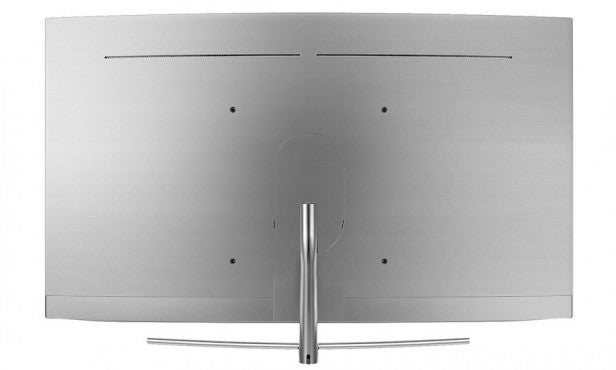Samsung QE55Q8C QLED Review
Samsung QE55Q8C QLED
QLED tech meets curved screen with intriguing results
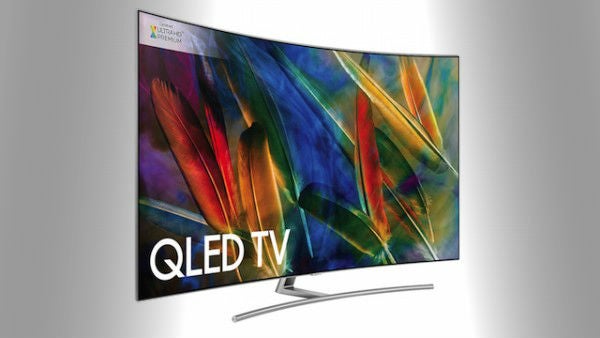
Verdict
Pros
- Exceptionally bright, colourful HDR pictures
- Very watchable in ambient light
- Pretty design
Cons
- It's rather expensive
- Backlight striping around stand-out bright HDR objects
- Banding with some HDR colour blends
Key Specifications
- Review Price: £2999.99
- Samsung QLED screen technology
- 55-inch 4K HDR TV
- HDR10, HDR10+ and HLG HDR support
- Eden smart platform
- Multimedia playback from DLNA and USB
What is the Samsung QE55Q8C?
The QE55Q8C (QN55Q8C in the US) is the third TV we’ve tested from Samsung’s new QLED range. It sits between the Q7F and the top-end Q9F, both seriously impressive TVs in many ways.
As such, it’s no surprise to find the Q8C serving up exceptional brightness and a huge colour range, while also using class-leading screen filters to deliver unprecedentedly excellent pictures in bright room conditions.
However, it’s also no surprise to find its HDR-friendly charms coming at the cost of a few backlight issues.
Related: Best 4K TVs
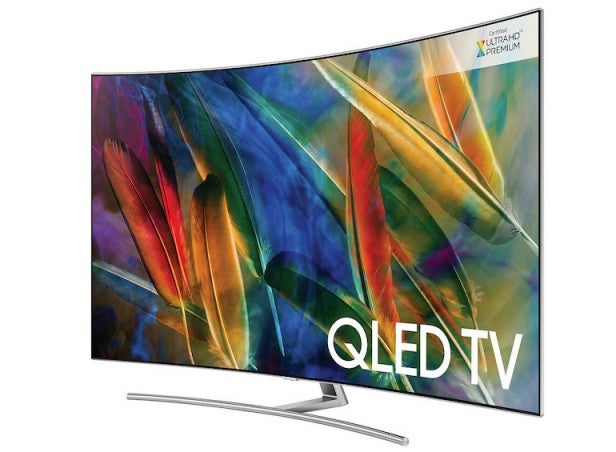
Samsung QE55Q8C – Design and Build Quality
While I personally have a soft spot for the clean, industrial design of Samsung’s flagship TV for 2017, the Q9F, I suspect most people will prefer the look of the 55-inch Q8C. Its W1226 x H706 x D91mm black-and-silver frame is less in your face; its edges look thinner; and its centrally mounted metallic bar-style stand helps to create a lighter, more airy feel.
The silver metallic rear panel also feels less severe than the darker, monolithic back of the Q9F. Although this only matters if you regularly look at your TV’s back end.
The one controversial thing about the QE55Q8C’s screen is that it’s curved, in stark contrast to the flat Q7F and Q9F models. For an in-depth look at the reasons behind curved TVs, check out our handy guide – Curved TVs: the pros and cons.
The QE55Q8C is as well made as it is attractive, feeling sturdy on its stand and catching your eye with the sort of opulent metallic gleam you’d hope to see from a TV costing £3000.
Supplied with the set are two remote controls: a ‘normal’ one packed with all the traditional buttons, and a more minimalist ‘smart’ remote. The latter is actually something of a revelation, combining a metallic form with a sensibly reduced button count, an ergonomic layout, and access to the most straightforward and usable voice-control system yet seen on a TV.
Argos Deal: Get these Samsung 4K Ultra HD TVs for the World Cup from only £349.00 – Our lowest prices
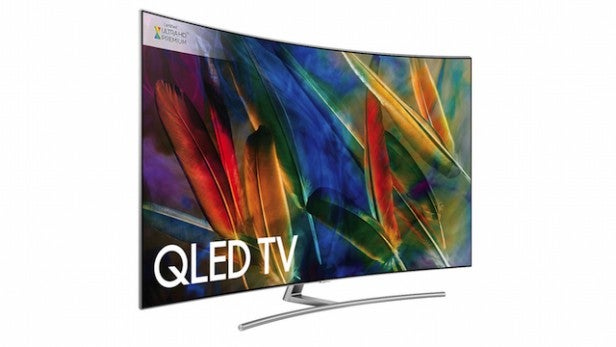
Samsung QE55Q8C – Features
As you’d hope of a TV that costs £3000, the Q8C supports both a native 4K resolution and HDR playback. In fact, its HDR support extends beyond the HDR10 industry standard format to the new Hybrid Log-Gamma (HLG) format set to be used for HDR broadcasts. It also supports the new HDR10+ format, an open-source rival to Dolby’s metadata-toting Dolby Vision.
Amazon Video has announced that it will support HDR10+, but no other sources have yet been confirmed. Samsung doesn’t support Dolby Vision despite it being available on Netflix, Amazon and Ultra HD Blu-ray disc.
Arguably, the Q8C’s most important feature is Samsung’s ‘QLED’ technology. This seeks to improve on the already-established Quantum Dot approach to colour reproduction by wrapping the QDs within a metallic casing so that they can be driven harder. This should result in better brightness and colour performance.
The QE55Q8C’s connections are all carried on an external ‘One Connect’ box, and comprise four HDMIs, three USBs, Bluetooth support, and both Wi-Fi and Ethernet network options. The network options support multimedia streaming from networked DLNA devices, and access to Samsung’s wide selection of connected TV services. The USB ports can be used to record to USB drives from the TV’s Freeview HD tuner, or to play multimedia from USB storage devices.
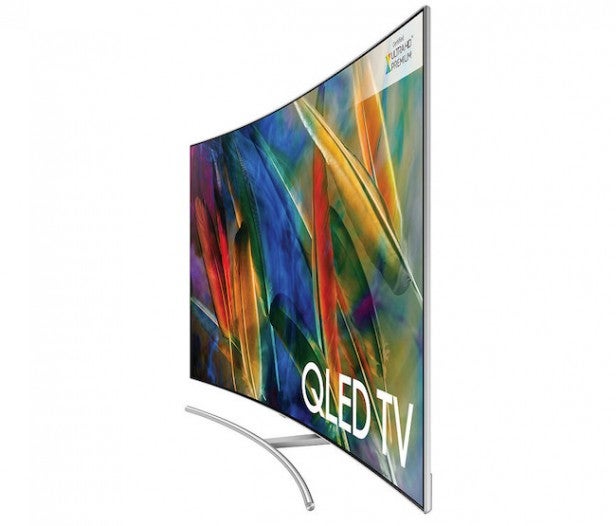
The One Connect box attaches to the screen via a single cable, to reduce cable spaghetti. This connection cable is so thin and so nearly transparent that, from a distance, the TV looks like a completely cable-free zone. You’ll still have to hide the power cable, mind.
Samsung’s latest ‘Eden’ smart interface is the brand’s most effective system yet. It uses a well-presented and slick two-tier icon system to streamline access to content sources. It makes it easy to customise which apps and sources appear where on the homepage.
It’s good to see that Eden now supports the BBC iPlayer, ITV Player, All 4 and My5 catch-up TV apps, as well as the more predictable Netflix and Amazon Video services. Incidentally, these latter two services can be enjoyed in 4K and HDR on the Q8C when the show you’re watching supports them.
According to Samsung’s official figures, the Q8C is capable of hitting light peaks of around 1500 nits – one of the highest figures I’ve seen on a TV to date. My own measurements reveal a more realistic peak of around 1360 nits, but this is close enough to Samsung’s claims to suggest that the set can indeed momentarily hit 1500 nits or so over small areas of the screen that contain areas of extreme HDR brightness.
These sort of brightness figures should enable the Q8C to deliver HDR’s brightness peaks more effectively than most current TVs, as well as giving colours a more real-world intensity or ‘volume’.
Samsung QE55Q8C – Setup
Getting the QE55Q8C’s screen mounted onto its stand is complicated and fiddly. Steps include laying the TV in its box face-down on the floor, and ripping off one side of its box. It’s easy to imagine it becoming damaged at the hands of people in a rush to get their new TV up and running.
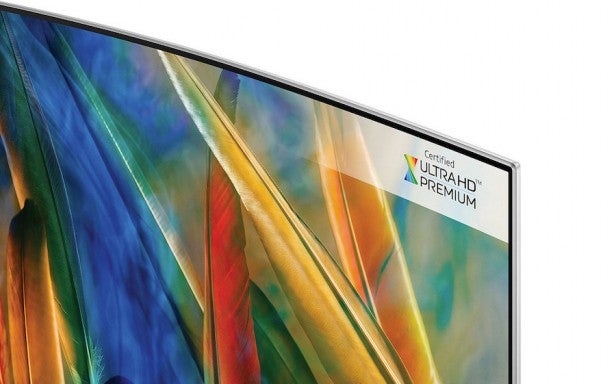
Fortunately, the Q8C redeems itself by providing an exceptionally straightforward initial installation routine, which even sees the TV auto-tuning itself in the background while you carry on with other installation steps.
The TV goes beyond rival brands by auto-detecting and auto-labelling the HDMI inputs of your connected equipment. It’s not foolproof, though – it failed to label my resident Panasonic UB900 Ultra HD Blu-ray player.
Once the Q8C has recognised a source, it lets you control it via the TV’s smart remote. While Samsung has tried to improve the way source functions map to the smart remote’s buttons, I still don’t think it’s a feature most people will bother with. It’s just easier to pick up your source equipment’s own remotes.
Getting the best out of the Q8C’s pictures is pretty easy when you’re using it in a bright room. You can simply use the Standard picture preset with noise reduction turned off.
If you’re watching SDR content, you’ll additionally need to decide whether you want to watch it with Samsung’s HDR+ system in play. HDR+ aggressively increases the brightness and colour content of the image to make it look more like HDR. I’d argue it works well enough to be worth at least experimenting with in a bright room, although I acknowledge that it won’t suit everyone’s tastes.
If you’re viewing in a dark room, you’ll need to try to combat some backlight banding issues. Switching to Samsung’s new Calibration Night setting deals with this issue the best, but causes dark parts of the picture to look hollow and empty.
Otherwise, you can reduce its impact by turning down the image’s brightness and minimising the local dimming system – which enables different sections of the edge-based lighting to output different levels of light. But, obviously, both of these options compromise the picture in different ways.
Samsung QE55Q8C – Picture quality and sound
If your first experience of the Q8C in action is in a bright room – or on a bright shop floor – you may well think it’s the most amazing TV you’ve ever seen. The new screen filter system and the way the Quantum Dots are illuminated reduces the negative impact of on-screen reflections to astonishing levels we’ve only seen on Samsung’s other QLED TVs.
The result is pictures that retain more brightness, colour richness and, above all, greater contrast than you’d normally expect a TV to dish up in a bright environment. This is especially true when you’re watching HDR content, or SDR content with the HDR+ mode on.
Related: Best TVs 2017
This almost-magical ability to ‘punch through’ ambient light is a big deal. After all, most households spend the majority of their time watching TV with the lights on, or in a sun-drenched room. So any TV that can handle such a setting as well as the Q8C is off to a flying start.
It isn’t only the ability to soak up ambient light that makes the Q8C such an effective daytime performer. Its exceptional brightness is also instantly obvious with HDR content, driving both bright highlights and rich, vibrant colours off the screen to spectacular effect. No non-QLED TVs manage to look as dynamic in a bright room.
What’s more, the extreme brightness is able to share screen space with remarkably deep and natural black levels – something that’s usually the first picture quality victim of a brightly lit room. Add all this together and it’s possible that, for the first time in TV history, you have a TV technology that allows even serious AV fans to watch a film without having to turn off all the lights and close all the curtains. At least if that film is available in HDR.
Its bright-room talents are far from the Q8C’s only performance strengths. Its pictures are also exceptionally crisp and detailed, for instance. This is especially true with native 4K content, but it also boasts an impressively precise and intelligent 4K upscaling engine.
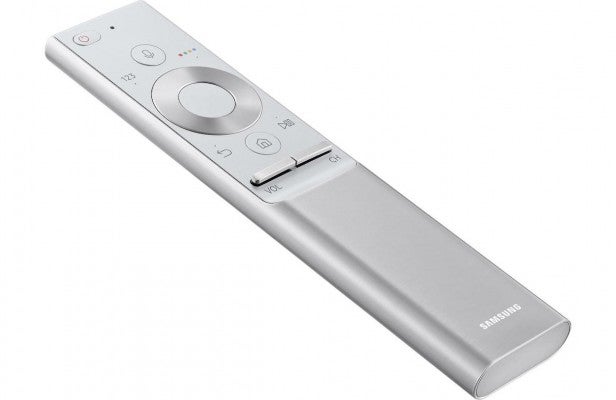
The clarity remains largely intact when there’s motion to be dealt with, too. The Q8C suffers with only minor judder and blur, even if you deactivate all the provided motion processing system entirely, as many AV fans will prefer to. However, I’d argue that you can use the motion processing on its Custom setting with judder and blur reduction both set to around level three, without the picture starting to exhibit serious amounts of unwanted processing side effects.
If you switch to a dark-room setting, the explosive impact of the Q8C’s dazzling brightness and colour volumes becomes even more pronounced, making the HDR pictures of many rival TVs look barely HDR by comparison.
It’s also becomes easier to appreciate just how impressively deep the Q8C’s black levels are able to get by LCD standards – and how much detail it’s able to render in its darkest areas when you’re using its Standard or, to a lesser degree, Movie picture presets.
The Q8C also outperforms any rival TV brand in terms of the amount of detail it’s able to reproduce in the very brightest parts of HDR pictures, avoiding almost all traces of the ‘clipping’ problems that can leave bright highlights looking bleached of detail.
While the QE55Q8C’s dark room pictures often look stellar with both HDR and SDR sources, they do suddenly start to struggle when an HDR image contains a contrast-rich mix of bright and dark image elements.
The issue is that since the Q8C lights its pictures from its horizontal edges, the only way it can illuminate a bright HDR object that appears within a mostly dark backdrop is to shine a beam of light across pretty much the entire height of the screen. Since the TV is able to get different sections of its edge LED lighting to output different levels of brightness, these vertical light beams can stand out prominently over dark parts of the picture that surround the bright object.

To be fair, this sort of backlight striping is hardly unique in the edge-lit LCD world. It’s slightly more pronounced here than it is on many rival TVs, though, by the Q8C’s relatively extreme levels of HDR brightness and contrast.
The curvature of the screen likely isn’t helping here, either; experience suggests that curved screens find it harder to control light precisely. This may explain why the slightly cheaper Q7F actually seems to perform better than the Q8C in this key performance area.
The backlight striping is sometimes sufficiently strong to negatively impact colour tones over which it appears, reducing their otherwise bold saturations. Finally regarding this issue, the striping’s obviousness increases if you have to watch the screen from an angle of more than around 25-30 degrees.
The Q8C also very occasionally suffers from banding over expanses of similar colour when watching HDR/wide colour sources. This affects a number of other brands of HDR TV, too. But there are sets out there – especially Sony’s latest models – that manage to avoid it.
One other minor niggle is that although the Q8C’s screen soaks up reflections fantastically well by the LCD standards, its curved nature means residual reflections are distorted across a greater area of the screen than they are on flat models.
The Q8C deserves to have us wrap up in a positive frame of mind, though. So let’s do that by first pointing out that it takes only 27ms (on average) to produce its images when running in its Game mode, and also that its sound is surprisingly powerful and clean – especially for a TV that doesn’t appear to carry any visible speakers.
Deal: SAMSUNG 65-inch 65MU7000 4K Ultra HD TVs for the World Cup from only £1,079
Why buy the Samsung QE55Q8C?
If you spend the majority of your time watching TV in a bright room and you like the idea of a curved-screen TV, then the QE55Q8C is uniquely qualified to satisfy your needs. There really is no other curved TV out there that’s as capable of combating the picture quality issues associated with ambient light. With this unique ability in mind, the set arguably justifies its steep £3,000 asking price.

However, if you’re not caught up on the curve then you could save yourself £700 and get a similarly strong picture from Samsung’s own Q7F QLED model.
LG, meanwhile, offers a different set of picture priorities built around deep, uniform blacks and wide viewing angles with its £3,000 OLED55B7, while Sony’s 55XE9305 combines similar levels of brightness and colour resolution to the Q8C with slightly more precise backlighting for £600 less – although its pictures don’t hold up as well in ambient light.
Verdict
Exaggerated backlight striping issues may be a distraction for dedicated home cinema fans. But for more casual users the Samsung QE55Q8C is a beautifully designed and uniquely talented TV that’s just about ‘out there’ enough to justify its £3000 price tag.
How we test televisions
We test every TV we review thoroughly over an extended period of time. We use industry standard tests to compare features properly. We’ll always tell you what we find. We never, ever, accept money to review a product.
Trusted Score
Score in detail
-
Features 9
-
Value 7
-
Smart TV 9
-
Image Quality 8
-
Design 8
-
Sound Quality 8

